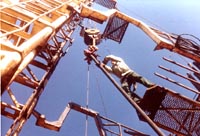

GUARANTEED GROUND-WATER EXPLORATION AND WELL-SITE SELECTION PROGRAM WEST OF ALBUQUERQUE, NEW MEXICO, U.S.A.
William M. Turner, Ph.D.
We, at American Ground Water Consultants (AGW Consultants), were retained by a major client seeking to develop a national caliber automobile racing facility west of Albuquerque, New Mexico. The location of the site is shown in Figure 1. No municipal water services exist in the area and there are no plans to extend water lines to the project. In fact, the extension of lines into the area by the City of Albuquerque is not planned for many years.
Government planning boards, however, required a proven supply of water for the project before granting final approval and building permits. We were retained to bring water to the property.
We proposed to guarantee water to the project in return for our consulting fees and a royalty payment based on water production. Our downside was that we would have to acquire water rights and build the pipeline. Our offer was accepted.
HYDROGEOLOGIC SETTING
Eighteen miles west of Albuquerque, New Mexico the geologic world has changed drastically from 15,000 feet (5,000 m) of Tertiary, basin-fill, alluvial material of the Rio Grande rift valley to thousands of feet (1,000s m) of Paleozoic and Mesozoic rocks of the San Juan Basin. The major boundary between the two geologic provinces is the Nacimiento Fault zone.
PROCEDURE
|
|
|
|
Our client hired Stewart Brothers Drilling Company of Grants, New Mexico to drill and construct a test well. Schlumberger was hired to run a complete set of wireline geophysical logs and a sidewall formation tester and a compensated magnetic resonance log.
|
|
RESULTS
We encountered the top of the Gallup Sandstone at 2,550 feet (869 m) below land surface and terminated drilling at 2,793 feet (952 m) below land surface. The well was logged with a complete suite of geophysical logs to not only determine formation tops but to determine formation porosity, permeability and water quality. The Gallup Sandstone is 128 feet (44 m) thick at the well site. Water in the well is under significant pressure and stands 50 feet (14 m) from the land surface.
We conducted an aquifer performance test using the well. We calculated the undamaged aquifer transmissivity of about 3,099 gpd/ft (37 m2/).
We expected the quality of the water to be poor and we were not disappointed. It contains about 11,000 mg/l of total dissolved solids.
Based on the proven quantity of water now available at the site and based on reverse osmosis technology, governmental approvals were granted.
We performed on our guarantee of water and will begin drawing royalty payments when the project is constructed and placed into service.
FUTURE PLANS
Water produced from the Gallup Sandstone must be treated by reverse osmosis to create domestic drinking water. The reverse osmosis process creates a reject water that is higher in total dissolved solid concentration than the water produced from the well. Some of this water can be used for fire suppression but most of it must be either recycled or reused or both. Wastewater may even need to be reinjected.
The client plans to use the reject water, first, in an aquaculture project. It plans to raise shrimp or fish for local and national markets. More saline water from the aquaculture project will be used in solar, power generation ponds. Initial estimates are that 100 acres (86 Ha) of shallow, brine ponds can generate 5,000 MW of power. Finally, as the brine evaporates completely, salts in the water will be commercially processed and sold into local and national markets.
AGW formed a consortium of companies with international reputations to carry out this project.
? 1999 AGW Consultants. All Rights Reserved.


 Halliburton cement trucks.
Halliburton cement trucks.